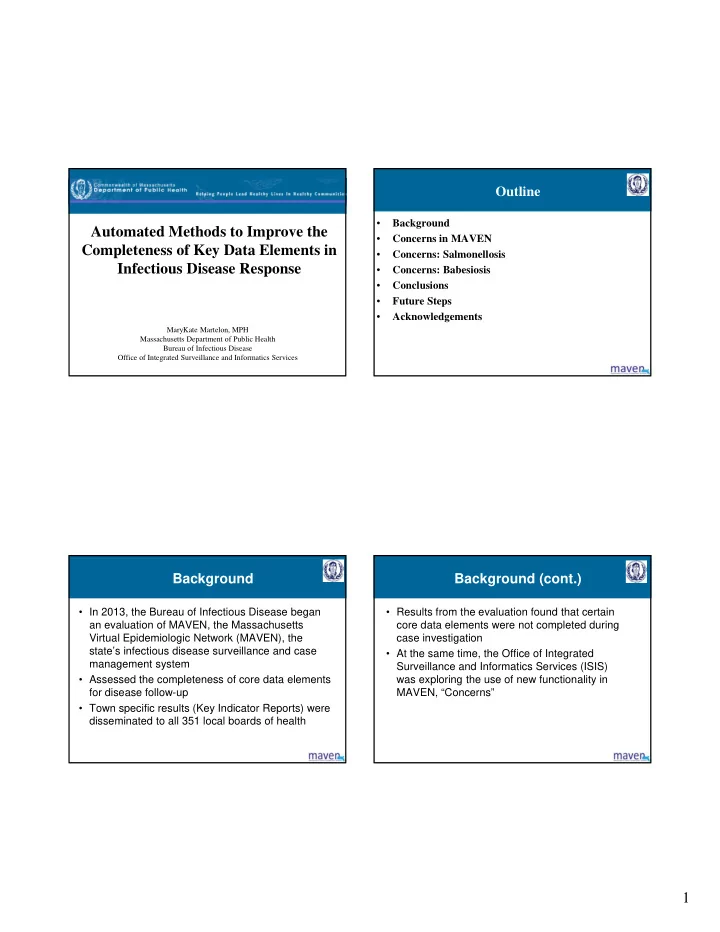

Outline • Background Automated Methods to Improve the • Concerns in MAVEN Completeness of Key Data Elements in • Concerns: Salmonellosis Infectious Disease Response • Concerns: Babesiosis • Conclusions • Future Steps • Acknowledgements MaryKate Martelon, MPH Massachusetts Department of Public Health Bureau of Infectious Disease Office of Integrated Surveillance and Informatics Services Background Background (cont.) • In 2013, the Bureau of Infectious Disease began • Results from the evaluation found that certain an evaluation of MAVEN, the Massachusetts core data elements were not completed during Virtual Epidemiologic Network (MAVEN), the case investigation state’s infectious disease surveillance and case • At the same time, the Office of Integrated management system Surveillance and Informatics Services (ISIS) • Assessed the completeness of core data elements was exploring the use of new functionality in for disease follow-up MAVEN, “Concerns” • Town specific results (Key Indicator Reports) were disseminated to all 351 local boards of health 1
Concerns in MAVEN Concerns in MAVEN • Concerns • Concerns appear in the main notification section are color- of a disease event coded • Highlight critical questions that need to be text completed during case follow-up which are specific to a disease event Concerns in MAVEN Concerns for Salmonellosis • Once the questions have been answered, the • For salmonellosis and other enteric diseases, ISIS created the following concern: “Please note the case’s occupation in the Concerns disappear from the notification section Demographic Question Package.” 2
Concerns for Babesiosis Methods • For babesiosis, ISIS created the following concern: “Please • At the end of 2014, we assessed whether concerns note in the Risk/Exposure/Control & Prevention Question were effective in improving completeness Package whether or not the case has received a blood • Using SAS (9.3), we compared percentages of transfusion, tissue products or organ transplant in the past completeness between 2013 and 2014 using year.” logistic regression • To determine whether concerns were the main reason behind a possible improvement, we also compared percentages of completeness with other core variables in the key indicator reports that were not highlighted by concerns Comparison to other core variables Salmonellosis without a concern: salmonellosis Occupation • Completeness of Occupation information between 2013 and 2014 20% Number of Confirmed Cases 50% 20% 20% N=228 Number of Confirmed Cases 50% N=228 N=576 50% N=228 Travel Before Symptom Onset N=576 Odds Ratio:3.95; N=576 95% Confidence 19% 16% Number of Confirmed Cases Interval: 3.28, 4.76; N=219 N=179 p-value <0.0001 30% reduction in missing information vs. a 3% reduction in missing information Events in 2014 were 4 times more likely to have Occupation completed compared to events in 2013 3
Comparison to other core variables Babesiosis without a concern: babesiosis • Completeness of Blood Transfusion, Tissue or Organ Blood Transfusion Transplant Information between 2013 and 2014 9.5% N=46 20% Number of Confirmed Cases Hospitalized N=77 9.5% Number of Confirmed Cases Odds Ratio:2.34; 8% N=46 20% 95% Confidence N=41 11% Number of Confirmed Cases N=77 Interval: 1.58, 3.47; N=44 p-value <0.0001 10.5 % reduction in missing information vs. a 3% reduction in missing information Events in 2014 were 2.3 times more likely to have blood transfusion information completed compared to events in 2013 Conclusions Future Steps • Incorporating concerns in MAVEN significantly • ISIS is now considering other diseases where improved completeness for core variables concerns would be useful • Although we saw some improvement in the other • ISIS plans to continue monitor the completeness core variables, questions with concerns were more of these questions to see if this trend continues effective in prompting a response 4
Acknowledgements • MDPH – Sue Soliva – Scott Troppy – Gillian Haney – Pat Kludt Thank you marykate.martelon@massmail.state.ma.us 5
Recommend
More recommend